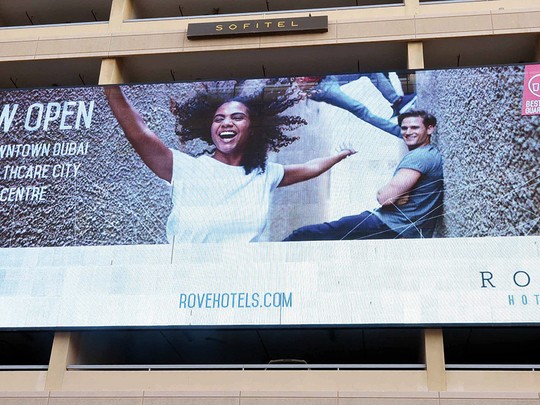
Dubai: Digital media isn’t just showing up on your smartphones ... in Dubai, digital billboards are getting bigger and occupying the most prominent of consumer hotspots. The Meraas-owned Citywalk retail precinct is already awash with giant screens — featuring everything from Rolls-Royce cars to Zaha Hadid home accessories — and this is being played out elsewhere in the city.
“Just a decade ago, top-to-bottom wrappings on the newest high-rises were the rage among marketers who could afford it,” said Yasmeen Siddiqui, Chairperson of Shura Advertising. “Now, mega-screens as billboards are dominating the scene, and there’s significant take-up among advertisers.
Shura Advertising recently installed a 207 square metre screen near The Dubai Mall metro, and which, given the high-volume traffic, will expose those travelling that stretch — either pedestrian or in a car — to 5-6 minutes of messages.
“In marketers’ perspective, any such direct and indirect exposure could have a bearing on influencing consumers,” said Siddiqui. “Currently, two of the city’s biggest screens are located at Citywalk, at 397 square metres and 246 square metres. Our Dubai Mall screen comes third with 207 square metres.” According to market sources, a 15-second spot on digital outdoor media screens could be anywhere from Dh70,000-Dh80,000 a month. Stretches down the Shaikh Zayed Road also sport instantly recognisable screens, with the one at the recently opened McLaren’s showroom being particularly prominent.
“How long marketers run individual digital outdoor campaigns is entirely dependent on their budget spend plans,” said Siddiqui. “But as an advertising category, it is one of the fastest growing platforms in the city and commanding a top dollar for the prime locations. The majority of these are tactical campaigns, to establish a brand name among the intended audience. Not, surprisingly, it’s the visuals that do much of the talking.” (The screens incorporate the latest in mesh technologies to ensure they can resist extreme weather patterns.)
With their ad budgets cut down drastically, more marketers could see the virtue of committing to high visibility, high impact outdoor campaigns. “For the moment, digital outdoor is still a novelty in Dubai — and because of its structure and costs, it’s only the premium brands that tend to utilise it now,” said an ad industry source. But to stand out from the crowd — literally — these screens do offer an edge.
“Because campaigns through building wraps and traditional billboards have started to become too common.”
Advertisers are looking to any opportunity that maximises their access to captive audiences. Given the traffic snarls on Dubai’s roads, it means that outdoor media — digital and traditional — as well as radio stations score quite well.
“The concept of “peak times” has little or no relevance since we see traffic right through the day,” said Glenn Netto, Director — Buying at BPG Maxus, the media agency. “Hence, OOH (out-of-home) advertising/radio advertising is doing reasonably well in these difficult times.
“Both are certainly cost-effective and specific brands (primarily retail) are using it in a big way. OOH digital screens as well as elevator screens in select areas in DIFC, Downtown or Business Bay also serve the purpose for call-to-action or brand recall campaigns.
“With radio advertisers are now gradually moving to content driven messages or sponsored capsules and this is the way forward. Spots are getting a bit boring as they get aired across quite a few stations and hence the repetitiveness tends to switch off the consumer.”











